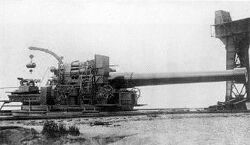Engineering:List of the largest cannon by caliber
This list contains all types of cannon through the ages listed in decreasing caliber size. For the purpose of this list, the development of large-calibre artillery can be divided into three periods, based on the kind of projectiles used, due to their dissimilar characteristics, and being practically incommensurable in terms of their bore size:
- Stone balls: Cannon of extraordinary bore, which fired stone balls, were first introduced at the turn of the 14th to 15th century in Western Europe. Following a logic of increasing performance through size, they had evolved from small handguns to giant wrought-iron or cast-bronze bombards within a span of just several decades.[1]
- Iron balls and shot: By the 16th century, however, a general switch from stone balls to smaller, but much more effective iron projectiles was in full swing. This and the parallel tendency towards standardized, rapid-firing cannon made the enormously costly and logistically demanding giant guns soon obsolete in the European theatre (with the exception of the odd showpiece).[2]
- Explosive shells: In the Industrial Age, artillery was again revolutionized by the introduction of explosive shells, beginning with the Paixhans guns. Breakthroughs in metallurgy and modes of production were followed up by new experimentation with super-sized caliber weapons, culminating in the steel colossi of the two World Wars. In the post-war era, the development of extremely overpowered artillery was gradually abandoned in favour of missile technology, while heavy guns are still demanded by various arms of the service.
Cannon by caliber
Stone balls
Heyday: 15th to 17th centuries
| Caliber (mm) | Name | Type | Produced | Place of origin | Made by | |
|---|---|---|---|---|---|---|
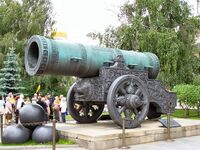
|
890[CB 1] | Tsar Cannon | Bombard | 1586 | Andrey Chokhov | |
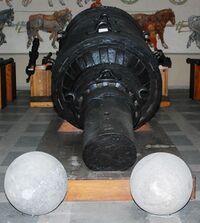
|
820[CB 2][3] | Pumhart von Steyr | Bombard | 1425 Early 15th century
|
House of Habsburg, Template:Country data Holy Roman Empire | |
| 745[CB 3] | Basilic | Bombard | 1453 | Orban | ||
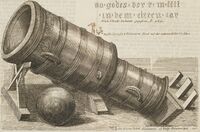
|
735[CB 4][6] | Faule Mette | Bombard | 1411 | City of Brunswick, Template:Country data Holy Roman Empire | Henning Bussenschutte |
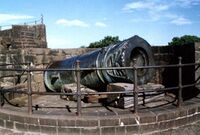
|
700 | Malik-i-Maidan | Bombard | 1549 {{{2}}}
|
City of Bijapur, Adil Shahi dynasty | Muhammad Bin Husain Rumi |

|
660[7] | Dulle Griet | Bombard | 1425 First half of 15th century
|
City of Ghent, County of |
|
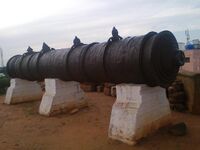
|
635 | Thanjavur cannon (Rajagopala Beerangi) | Bombard | 1620 | Thanjavur Nayaks | Vikas Naikwade |
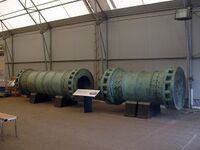
|
635[8] | Dardanelles Gun or Great Turkish Bombard | Bombard | 1464 | Munir Ali | |
| 530[9] | Galeazzesca Vittoriosa | Bombard | 1471 | Caliber: 530 mm (ball diameter); Mass: ~ 8.6-8.8 t; Shell weight: 209 kg[10] |
Giovanni Garbagnate | |
| 520[11] | Faule Grete | Bombard | 1409 | Monastic state of the Teutonic Knights | Heynrich Dumechen | |
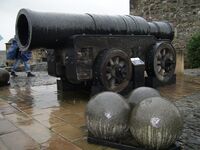
|
520[12] | Mons Meg | Bombard | 1449 | Mons, County of Hainaut, Duchy of Burgundy | Jehan Cambier |
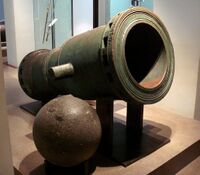
|
510[CB 5][13] | Bombard | 1480 | Knights Hospitaller |
Iron balls and shot
Heyday: 16th to 19th centuries
| Caliber (mm) | Name | Type | Produced | Place of origin | Made by | |
|---|---|---|---|---|---|---|
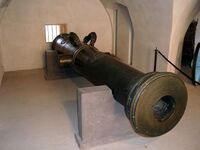
|
280[14] | Kanone Greif | Scharfmetze ("medium size") | 1524 | Electorate of Trier | Master Simon |
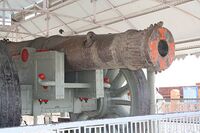
|
280 | Jaivana | 1720 | Jaigarh Fort, Jaipur Riyasat, | ||
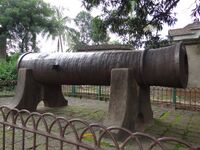
|
286 | Dal Madal Kaman/Dala Mardana | 1565[15][16] | Mallabhum, Malla dynasty | Jagannath Karmakar | |
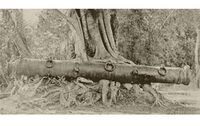
|
152 | Jahan Kosha Cannon | 1637[17][18] | Bengal Subah, Mughal Empire | Janardan Karmakar | |

|
240 | Zamzama | 1757 | Durrani Empire | Shah Nazir | |

|
508 | Dahlgren smoothbore cannons | 1864 | American Civil War | John A. Dahlgren | |

|
508 | Rodman gun | 1864 | American Civil War | Thomas Jackson Rodman |
Twenty-inch (508 mm) Rodman and Dahlgren smoothbore cannons were cast in 1864 during the American Civil War[citation needed][clarification needed]. The Rodmans were used as seacoast defense. Although not used as intended, two 20-inch Dahlgrens were intended to be mounted in the turrets of USS Dictator and USS Puritan. Both Rodman gun and Dahlgren gun were designed to fire both shot and explosive shell.
Explosive shells
Heyday: 19th to 20th centuries
| Caliber (mm) | Name | Type | Produced | Place of origin | Made by | |
|---|---|---|---|---|---|---|
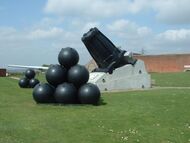
|
914 | Mallet's mortar | Mortar | 1857 | Robert Mallet | |
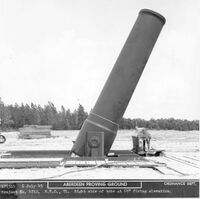
|
914 | Little David | Mortar | 1945 | ||

|
800 | Schwerer Gustav | Railway gun | 1941 | Krupp | |
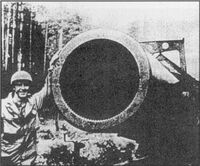
|
800 | Dora | Railway gun | 1942 | Krupp | |
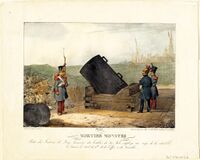
|
610[19][20] | Mortier monstre | Mortar | 1832 | Henri-Joseph Paixhans | |

|
600 (later, 540) |
Karl-Gerät | Mortar | 1940 | Rheinmetall | |

|
520 | Obusier de 520 modèle 1916 | Railway howitzer | 1918 | Schneider et Cie | |

|
508 | Dahlgren smoothbore cannons | Naval gun | 1864 | John A. Dahlgren | |

|
508 | M. 1864 20-inch Rodman gun | Naval gun | 1864 | Thomas Jackson Rodman | |
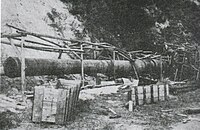
|
480 | 45 caliber 5 Year Type 36 cm gun | Naval gun | 1918–1922 | Kure Naval Arsenal | |

|
460 | 46 cm/45 Type 94 | Naval gun | 1940 | Kure Naval Arsenal | |
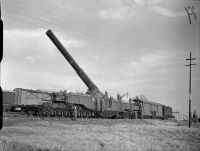
|
457.2 | BL 18 inch railway howitzer | Railway howitzer | 1920 | Elswick Ordnance Company | |
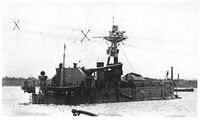
|
457.2 | BL 18 inch Mk I naval gun | Naval gun | 1916 | Elswick Ordnance Company | |
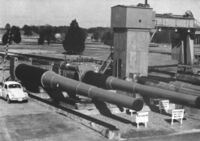
|
457 | 18"/48 caliber Mark 1 gun | Naval gun | 1942 | ||
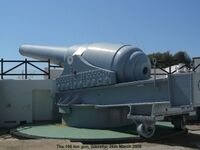
|
450 | 100-ton gun(RML 17.72 inch gun) | Naval gun | 1877 | Elswick Ordnance Company | |
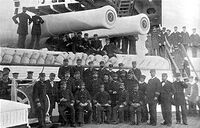
|
432 | 432 mm (17 in) guns | Naval gun | (?)1877 | (?) |
(?)Elswick Ordnance Company |
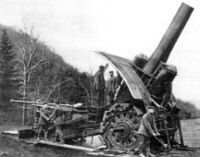
|
420 | Big Bertha | Howitzer | 1910s | Krupp | |
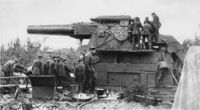
|
420 | 42 cm Gamma Mörser | Mortar | 1910s | Krupp | |

|
420 | 2B1 Oka | Self-propelled artillery | 1957 | KBM
Kirov Plant | |
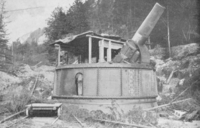
|
420 | 42 cm Haubitze M. 14/16 | Howitzer | 1914-1918 | Škoda | |

|
412.8 | BL 16.25 inch Mk I naval gun | Naval gun | 1888 | Elswick Ordnance Company | |
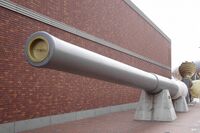
|
410 | 41 cm/45 3rd Year Type | Naval gun | |||
| 410 | Experimental 41-cm-Howitzer | Howitzer | 1926 | Empire of Japan | Japan Steel Works | |
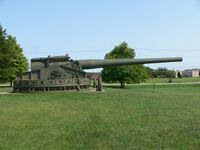
|
406 | 16"/50 caliber M1919 gun | Coastal Artillery | 1920 | Watervliet Arsenal | |
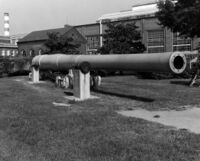
|
406 | 16"/50 caliber Mark 2 gun | Naval gun | 1920 | Washington Navy Yard, Washington, D.C., Bethlehem Steel | |

|
406 | 80-ton gun(RML 16 inch gun) | Naval gun | 1874 | Royal Gun Factory | |
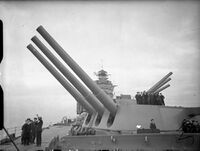
|
406 | BL 16 inch Mk I naval gun | Naval gun | 1927 | ||

|
406 | 40.6 cm SK C/34 gun | Naval gun | 1934 | Krupp | |

|
406 | 2A3 Kondensator 2P | Self-propelled artillery | 1956 | KB SM
Kirov Plant | |
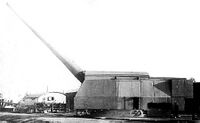
|
406 | 406 mm/50 B-37 naval gun for Sovetsky Soyuz-class battleships | Naval gun | 1937 | Barrikady Plant, Stalingrad | |
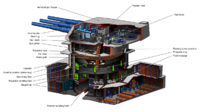
|
406 | 16"/50 caliber Mark 7 gun for the Iowa-class battleships | Naval gun | 1943 | Washington Navy Yard, Washington, D.C. |
See also
- List of artillery
- M65 Atomic Cannon
Notes
- ↑ The bombard has a conical bore of 82.5–90 cm.
- ↑ The bombard has a conical bore of 76–88 cm.
- ↑ Bown[4] indicates a larger bore of 36 in (914 mm), but Hollenback[5] says that Kritoboulos, a contemporary source, indicates a circumference of 12 spans and concludes that in this case the smallest of three possible sizes of span is the correct unit, giving 0.745 m for the bore. Hollenback also notes that granite cannonballs dating from the siege of Constantinople had a diameter of 0.711 and could have been shot from this weapon using a wooden sabot.
- ↑ The bombard has a conical bore of 67–80 cm.
- ↑ The bombard has a conical bore of 45–58 cm.
Footnotes
- ↑ Schmidtchen 1977b, pp. 228–230
- ↑ Schmidtchen 1977a, pp. 153–161
- ↑ Schmidtchen 1977a, p. 162; ball diameter is 20 mm less (p. 171, Fn. 41).
- ↑ Stephen R. Bown (2005). A Most Damnable Invention: Dynamite, Nitrates, and the Making of the Modern World. Penguin Group. ISBN 0-670-04524-1.
- ↑ George M. Hollenback (2002), "Notes on the Design and Construction of Urban's Giant Bombard", Byzantine and Modern Greek Studies 26 (1): 284–291, doi:10.1179/030701302806932231
- ↑ Schmidtchen 1977b, p. 222; ball diameter is 20 mm less (p. 171, Fn. 41).
- ↑ Schmidtchen 1977a, p. 164; ball diameter is 20 mm less (p. 171, Fn. 41).
- ↑ Royal Armouries
- ↑ E. Rocchi, Le artiglierie italiane nel Rinascimento, Rome, 1899
- ↑ L. Beltrami, La Galeazesca Vittoriosa, Milan, 1916
- ↑ Schmidtchen 1977b, p. 218; ball diameter is 20 mm less (p. 171, Fn. 41).
- ↑ Schmidtchen 1977a, p. 166; ball diameter is 20 mm less (p. 171, Fn. 41).
- ↑ Schmidtchen 1977b, p. 236, Fn. 103
- ↑ Archiv für die Officiere der Königlich Preußischen Artillerie- und Ingenieur-Korps, Vol. 19, Berlin, Posen, Bromberg 1846, p. 101
- ↑ Dasgupta, Biswas & Mallik 2009, p. 55.
- ↑ "ASI, Kolkata Circle". http://www.asikolkata.in/bankura.aspx#Dalmadal.
- ↑ Journal of the Asiatic Society of Bangladesh: Humanities, Volumes 36-38 Asiatic Society of Bangladesh, 1991
- ↑ The Land of the rupee Bennett, Coleman, 1912, the University of Michigan
- ↑ Meyers Großes Konversations-Lexikon, Vol. 14, Leipzig 1908, p. 160: "Mörser": caliber of 61 cm
- ↑ Journal des Sciences Militaires, 2nd series, Vol. 22, Paris 1838: caliber of 22 pouces = 59,6 cm (p. 49); outer diameter of the barrel: 1 m (p. 54)
References
- Schmidtchen, Volker (1977a), "Riesengeschütze des 15. Jahrhunderts. Technische Höchstleistungen ihrer Zeit", Technikgeschichte 44 (2): 153–173
- Schmidtchen, Volker (1977b), "Riesengeschütze des 15. Jahrhunderts. Technische Höchstleistungen ihrer Zeit", Technikgeschichte 44 (3): 213–237
- Dasgupta, Gautam Kumar; Biswas, Samira; Mallik, Rabiranjan (2009), Heritage Tourism: An Anthropological Journey to Bishnupur, A Mittal Publication, p. 55, ISBN 978-8183242943, https://books.google.com/books?id=_0_o9Qj1LOEC&q=Dalmadal&pg=PA18
 |

